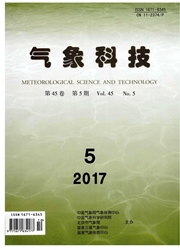

 中文摘要:
中文摘要:
利用常规气象观测资料、山东省123个自动站资料及NCEP1°×1°再分析资料,对2013年4月19—20日山东晚春极端暴雪天气过程的成因进行分析,重点分析了产生暴雪的温度条件。结果表明:前期气温偏低是晚春暴雪发生的气候背景,回流天气形势为暴雪发生提供了天气背景,低空西南风急流和山东北部纬向切变线是导致暴雪发生的直接原因。回流型暴雪天气过程的水汽及水汽的辐合均集中于700~500hPa。高低空急流的动力耦合以及与纬向切变线相应的对流层中的正涡度柱为暴雪的产生提供了动力条件。回流暴雪发生在对流稳定性大气中,暴雪区上空有θse能量锋锋生。受阻于太行山东麓的东北风形成的冷池,是气温骤降的温度环境背景,暴雪发生前,存在于850~700hPa冷空气团中的弱下沉运动导致了0℃等温线呈"漏斗状"向下延伸,造成了暴雪区地面气温的骤降,是降水相态由雨迅速转为雪的直接原因。0℃等温线呈"漏斗状"向下延伸区对未来降水相态由雨转雪区和暴雪出现区有指示意义。
 英文摘要:
英文摘要:
Based on the conventional observational data, automatic observational data of 123 stations in Shandong Province, and NCEP reanalysis data, the causes of a late spring extreme snowstorm on 19 and 20 April 2013 in Shandong Province are analyzed comprehensively, focusing on the temperature condition. The results show that the previous low temperature is the climate background, and the return-flow synoptic pattern, the low-level southwesterly jet, and the shear line in the north of Shandong are direct causes. The holding and convergence of water vapor were both happened in the layer between 700 and 500 hPa. The coupled reaction between high and low level jets and the positive vorticity column corresponding to the zonal shear line in the troposphere provided dynamic conditions for the snowstorm. The snowstorm of return-flow weather occurred in the atmosphere with convective stability, and there was energy frontogenesis of 0~ over the snowstorm area in the mid-low layer of the troposphere. Before the occurring of the snowstorm, the cold air pool accumulated by the return-flow northeasterly wind blocked by the eastern foot of Taihang Mountain was the background of sharply falling surface temperature. The weak descending motion of the cold air mass between 700 and 500 hPa leaded to a funnel-shaped 0 ℃ isotherm extending downward, resulted in the sharp falling of surface temperature and the conversion of precipitation phase from rain to snow in the snowstorm zone. So the zone with funnel-shaped 0 ℃ isotherm extending downward can be regarded as the indicator of the conversion of precipitation phase from rain to snow and the occurrence of snowstorm in the future.
 同期刊论文项目
同期刊论文项目
 同项目期刊论文
同项目期刊论文
 期刊信息
期刊信息
